|
|
|||
THIS WEEK at HILTON POND
22-30 September 2003
Installment #191---Visitor #
(Back to Preceding Week; on to Next Week)
|
|
|||
THIS WEEK at HILTON POND
22-30 September 2003
Installment #191---Visitor #
(Back to Preceding Week; on to Next Week)
|
WELCOME WARBLERS After five months and countless hours trying to catch Ruby-throated Hummingbirds at Hilton Pond Center, we're face-to-face with reality that--come October--nearly all our hummers will be gone and we'll have to go cold turkey on rubythroat banding until next spring. Were it not for the influx of migrant fall warblers, we likely would succumb to postpartum depression. Fall warblers--some confusing to identify--brighten our autumn days as much as the annual fall spectacle of leaves changing colors on the trees. When we operate our complement of mist nets scattered around the property, we never know what mysterious warbler species may suddenly appear, entwined in the mesh and waiting for us to remove it for identification. During the long last week of September 2003, we netted a nice but not overwhelming assortment of six warbler species, one of which is quite uncommon in the Carolina Piedmont and especially rare for Hilton Pond Center. 
All text & photos © Hilton Pond Center Since 1982, we've banded 43,035 birds of 123 species at the Center. Of those, 32 species have been Wood Warblers, for a total of 4,582 individuals; 61% have been what we lump together as "fall warblers," captured July through December. More than 40% of all spring and fall warblers have been Yellow-rumped (formerly Myrtle)--our fifth most common bird species that is exceeded in abundance only by the ever-plentiful Purple and House Finches and American Goldfinches, and by Ruby-throated Hummingbirds (see Abundance Chart 2). For ten of the 32 warbler species, we've banded less than ten individuals. One of the latter is the Black-throated Green Warbler, Dendroica virens, which breeds in the Coastal Plain and Mountain Regions of the Carolinas but seldom occurs in the Piedmont even in migration. We've banded only seven Black-throated Greens, one in spring and six in fall, including this week's immature (top photo and below). 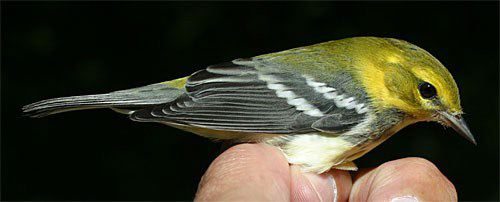 The Black-throated Green Warbler bears two field marks that, through their presence or absence, are used to identify many warbler species. The profile photo just above shows prominent "wing bars," markings created by white tips on two rows of covert feathers that overlap the plumage just posterior to them. This week we also netted three individuals of a species closely related to the Black-throated Green, namely the Magnolia Warbler, D. magnolia. All Dendroica warblers have wing bars and tails spots, and the immature Magnolia (below) is no exception. In the Magnolia, however, tail spots bisect the tail feathers and give the impression of a broad white band. Immature Magnolia Warblers also have a hazy gray necklace that separates the yellow throat and breast. At Hilton Pond, the Magnolia is much more common in fall (323 banded) than in spring (56). 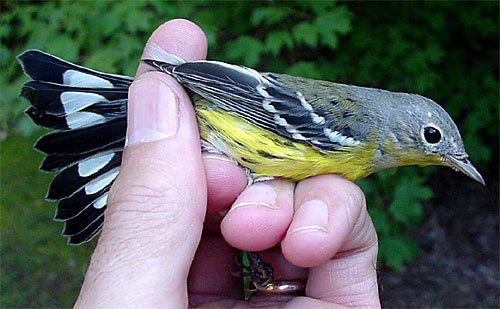 We've long wondered whether the American Redstart, Setophaga ruticilla, breeds locally--as it does in various locations around the Carolinas. We've caught females with brood patches in early August, but the majority of redstarts (234) have been banded at Hilton Pond Center in spring, with another smaller wave (128) passing through in fall migration. 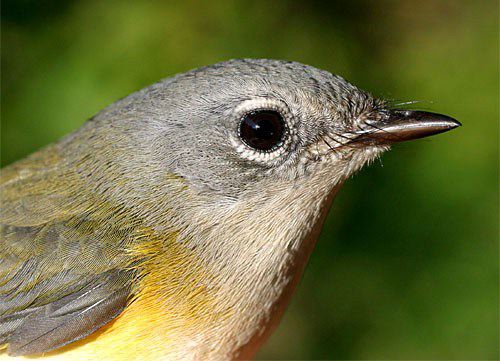 Most of the autumn birds are immatures with large single wing bars that are either yellow (males or females) or yellow-orange or salmon-colored (definitely males); these colors are repeated in a flank patch just ahead of the bend in the wing (above) and in the very large spots at the bases of the outer tail feathers (below). American Redstarts also show another field mark useful in identifying fall warblers: a ring of light-colored feathers around the eye. The redstart's eye ring is broken--i.e., the light feathers are only above and below the eye--but in other species is complete.  Since 1982, we've banded 65 Tennessee Warblers (below), ALL of which have been fall migrants, and 30 of which were netted in 1991. In spring this species apparently follows a migration path along the Mississippi Valley and into Canada, but in autumn fans out across the eastern U.S. on its way to Mexico or Central and South America. The Tennessee is one of our more nondescript warblers, with a greenish-yellow back and rump and no tail spots or wing bars. There is, however, a noticeable line of white feathers above the eye--a so-called "superciliary line" that is yet another field mark to look for in fall warblers. The slender, pointed bill of the Tennessee Warbler is a useful character in identifying this species. 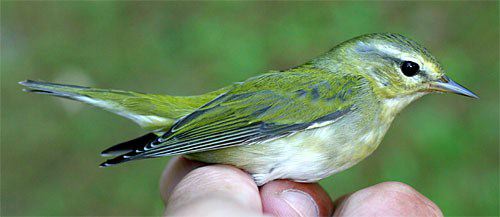 Another warbler that we see almost exclusively in fall is the Chestnut-sided, Dendroica pensylvanica, of which we've banded 68 individuals; all but five have come through in autumn. Even though these immature birds almost always lack the rusty flank stripes that give the species its name, young Chestnut-sided Warblers are always easy to identify from their gray cheek, complete white eye ring, and a neon yellow-green crown and back. This color is almost indescribable, but once seen it is not forgotten. 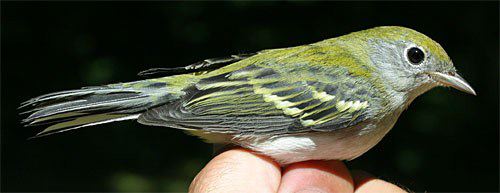 The last bird we netted during the period was an Ovenbird that looks nothing like the other warblers above. In fact, at first glance novice birders sometimes confuse the species with a thrush, especially since it hangs out on or near the ground while the other Wood Warblers are foraging at treetop height. The Ovenbird, Seiurus aurocapillus, is a brown-and-white warbler with heavy black breast streaking and a rusty crown patch bordered by two long parallel lines of dark feathers. We've banded 2002 Ovenbirds in the past 22 years, two-thirds of which have been in autumn. 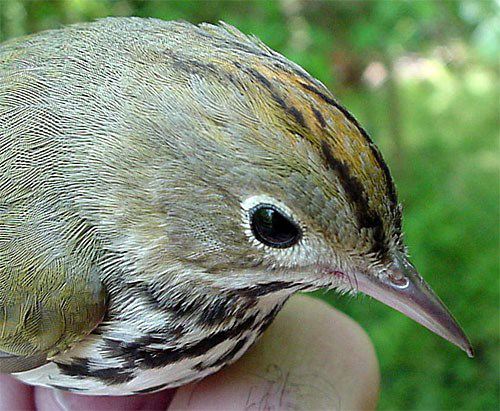 Yes, at Hilton Pond Center these fall migrants are welcome guests that help us get over the disappearance of Ruby-throated Hummingbirds. They also remind us that one benefit of bird banding is that it allows us to hold in the hand and identify conclusively what might otherwise pass by as just another "confusing fall warbler." NOTE: Be sure to scroll down for an account of all birds banded or recaptured during the week, as well as some other interesting nature notes. "This Week at Hilton Pond" is written and photographed by Bill Hilton Jr., executive director of Hilton Pond Center for Piedmont Natural History. You may wish to consult our Index of all nature topics covered since February 2000. You can also use the on-line Search Engine at the bottom of this page. For a free, non-fattening, on-line subscription to "This Week at Hilton Pond," just send us an E-mail with Subscribe in the subject line. Please be sure to configure your spam filter to accept E-mails from hiltonpond.org. |
|
Make direct donations on-line through
Network for Good: |
|
|
LIKE TO SHOP ON-LINE?
Donate a portion of your purchase price from 500 top on-line stores via iGive: |
|
|
Use your PayPal account to make direct donations:
|
|
|
|
|
SPECIES BANDED THIS WEEK: * = New species for 2003 WEEKLY BANDING TOTAL 17 species 38 individuals YEARLY BANDING TOTAL (2003) 55 species 921 individuals BANDING GRAND TOTAL (since 28 June 1982) 123 species 43.035 individuals NOTABLE RECAPTURES THIS WEEK (with original banding date, sex, and current age) Carolina Chickadee (1) Tufted Titmouse (1) VAGRANT HUMMINGBIRDS None this week |
OTHER SIGHTINGS OF INTEREST HUMMINGBIRD NOTES |
(Back to Preceding Week; on to Next Week)
|
|
|
Up to Top of Page Current Weather Conditions at Hilton Pond Center |
 post questions for The Piedmont Naturalist |
Join the |
Search Engine for |
|
|